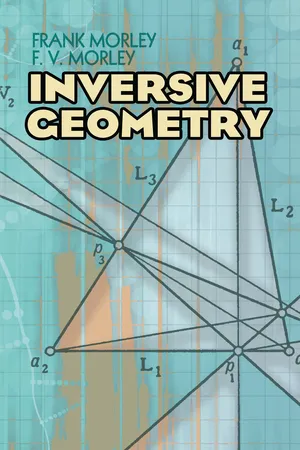
- 288 pages
- English
- ePUB (mobile friendly)
- Available on iOS & Android
eBook - ePub
Inversive Geometry
About this book
This introduction to algebraic geometry makes particular reference to the operation of inversion and is suitable for advanced undergraduates and graduate students of mathematics. One of the major contributions to the relatively small literature on inversive geometry, the text illustrates the field's applications to comparatively elementary and practical questions and offers a solid foundation for more advanced courses.
The two-part treatment begins with the applications of numbers to Euclid's planar geometry, covering inversions; quadratics; the inversive group of the plane; finite inversive groups; parabolic, hyperbolic, and elliptic geometries; the celestial sphere; flow; and differential geometry. The second part addresses the line and the circle; regular polygons; motions; the triangle; invariants under homologies; rational curves; conics; the cardioid and the deltoid; Cremona transformations; and the n-line.
The two-part treatment begins with the applications of numbers to Euclid's planar geometry, covering inversions; quadratics; the inversive group of the plane; finite inversive groups; parabolic, hyperbolic, and elliptic geometries; the celestial sphere; flow; and differential geometry. The second part addresses the line and the circle; regular polygons; motions; the triangle; invariants under homologies; rational curves; conics; the cardioid and the deltoid; Cremona transformations; and the n-line.
Frequently asked questions
Yes, you can cancel anytime from the Subscription tab in your account settings on the Perlego website. Your subscription will stay active until the end of your current billing period. Learn how to cancel your subscription.
No, books cannot be downloaded as external files, such as PDFs, for use outside of Perlego. However, you can download books within the Perlego app for offline reading on mobile or tablet. Learn more here.
Perlego offers two plans: Essential and Complete
- Essential is ideal for learners and professionals who enjoy exploring a wide range of subjects. Access the Essential Library with 800,000+ trusted titles and best-sellers across business, personal growth, and the humanities. Includes unlimited reading time and Standard Read Aloud voice.
- Complete: Perfect for advanced learners and researchers needing full, unrestricted access. Unlock 1.4M+ books across hundreds of subjects, including academic and specialized titles. The Complete Plan also includes advanced features like Premium Read Aloud and Research Assistant.
We are an online textbook subscription service, where you can get access to an entire online library for less than the price of a single book per month. With over 1 million books across 1000+ topics, we’ve got you covered! Learn more here.
Look out for the read-aloud symbol on your next book to see if you can listen to it. The read-aloud tool reads text aloud for you, highlighting the text as it is being read. You can pause it, speed it up and slow it down. Learn more here.
Yes! You can use the Perlego app on both iOS or Android devices to read anytime, anywhere — even offline. Perfect for commutes or when you’re on the go.
Please note we cannot support devices running on iOS 13 and Android 7 or earlier. Learn more about using the app.
Please note we cannot support devices running on iOS 13 and Android 7 or earlier. Learn more about using the app.
Yes, you can access Inversive Geometry by Frank Morley,F.V. Morley, F.V. Morley in PDF and/or ePUB format, as well as other popular books in Mathematics & Algebraic Geometry. We have over one million books available in our catalogue for you to explore.
Information
CHAPTER I
OPERATIONS OF ELEMENTARY GEOMETRY
§ 1. Instruments – Euclid’s plane geometry deals with figures, such as triangles, parallelograms, circles, in a plane. These are not pre-existent; they have to be either drawn or printed. In the phrase of Enriques, * they are werdende, not fertige. The drawing is done by instruments such as a straight rod or rule, or a combination of rods such as a triangle or a pair of compasses.
Let the instrument be a card lying on a table. We can then (thanks to the axioms) move the card freely over the table.
The card has a boundary; we take as the boundary a triangle, with three straight edges 1, 2, 3, and with the upper face marked. What we understand by straight is that the card can be turned over, keeping, say, the edge 1 fixed. The card will again fit the table, if both card and table are flat, and if the edge is straight. The marked face is now down.
We take this overturn as one of the fundamental operations of Euclidean geometry. If at first a point marked b of the card is over a point marked a of the table, then after the overturn the point marked b is over another point, say, a of the table. There is then set up in the table a correspondence of points with a line of fixed points, which we call a reflexion.
In the table is the record of the operation. By a usual trick of language, the same word reflexion will serve both for the operation and the correspondence which it sets up. Thus, instead of overturn we write reflexion.
Let us now make a second reflexion or overturn of the card, say about the edge marked 2. The marked face is now up. It seems that the result of the two reflexions could be obtained by moving the card along the table. Thus we get the idea that a planar displacement can be analysed into two reflexions. And this we take as a definition: a planar displacement is the product of two...
Table of contents
- Cover
- Title Page
- Copyright Page
- Dedication
- Contents
- Preface
- Part I
- Part II
- Index